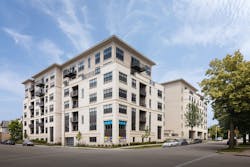Crafting a Sicilian Piazza in Milwaukee
Milwaukee, Wisc.
DESIGN TEAM:
AG Architecture
St. Rita’s Church was built in 1939 in Milwaukee’s Lower East Side and for years served as the heart of the Italian American community there. Two years ago, Capri Senior Communities set out to replace the beloved St. Rita’s, which had fallen into disrepair, and several unused buildings in the area with a six-story, senior-care campus that would include a church. The name of the project was St. Rita Square.
INFLUENCE:Designed by AG Architecture, the new senior living community incorporates architectural influences from the original St. Rita’s and Our Lady of Pompeii Church, another beloved religious structure at the center of Milwaukee’s Italian community. Setbacks at varied heights maintain a sense of modesty and scale, while providing residents with spectacular city views. The inclusion of an outdoor courtyard, or piazza, was a key programming component. “Italian piazzas are thought of as the heartbeat of Italian towns,” says Eric Harrmann, chief design officer at AG Architecture. “The piazza was created to be the heartbeat of this community, framed by the strong Sicilian feel of the masonry walls.”
SOLUTION:Echelon’s Cordova Stone was chosen to complement the Sicilian architecture that was identified as a precedent for the design of St. Rita Square.
Cordova Stone was recommended by GC Pepper Construction during the value engineering phase of the project. “The plans originally called for the building to be 100% stone, but that couldn’t be supported by the budget,” explains Ryan Eberly of Pepper Construction. “We recommended Cordova because it fit within the budget, matched the intent of the design and has the kind of durability required to endure Milwaukee’s four-season climate. What’s more, it’s a product we, the architect and masonry contractor were all very familiar with and had success with on other projects.”
Arteaga Construction, the masons on the project, also recommended it when they were asked to find cost savings in material and labor. “Cordova Stone was the obvious choice,” says Jamie Sadowske, field superintendent and project manager for Arteaga. “We knew the product would sustain the elements of the project as well as Milwaukee weather.”
Originally, 12-in. × 18-in. Cordova was specified for the facing of all six stories of the building. “It takes two men to lift each large stone, however, and that was impacting both the workforce required and the budget. The architect instead chose to instead use the larger stone at eye level (the bottom three stories) and then moved to the smaller Cordova (8-in. × 18-in.) for the higher levels,” says Eberly. “The reduced size stone also helped show the layering of the architecture, as the horizontal bands separated ‘layers’ of stone,” explains Harrmann. “The light-colored Cordova Stone and the horizontal layering of material and banding in this way is influenced by the type of Sicilian architecture the client wanted to reflect in this project.”
null